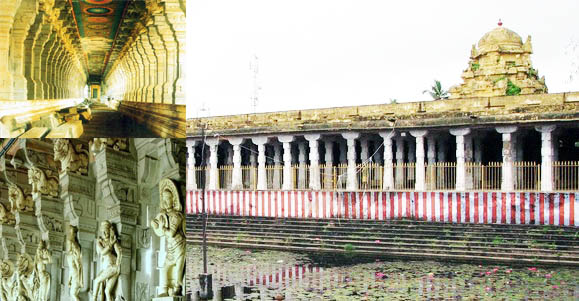|
|
Rameshwaram

Name of the Temple |
|
Location |
- Rameśhwaram temple is in the island of Rameśhwaram, down south of Tamilnāḍu
|
| How to reach there? |
- By Air : The nearest airport is located in Madurai, 163 km away. From the airport take the National Highway 87 south-east to reach Rāmeśhwaram.
- By Train : The Rāmeśhwaram railway station is just 2 km south from Rāmeśhwaram temple.
- By Road : Rāmeśhwaram is connected by the National Highway 87 from Rāmeśhwaram to Madhurai.
|
Rulers/builders and Time Period |
- The Rameśhwaram pilgrimage has long been a tradition in South India, particularly in Tamilnāḍu and has passed into folklore.
- Many kings of old prided themselves on having planted columns of victory in Rameśhwaram like Kriṣhṇa III the Rāṣhtrakūṭa, in the 10th century; the Hoysaḷa, Viṣhṇuvardhana, in the 12th century.
|
Deity/Deities |
|
Architecture Style |
- The temple is 264m east to west and 200m north to south, and with three Prakāras, two big Gopuras.Two more unfinished ones, faces east, a few metres from the sea.
- The western Gopura is smaller than the eastern, but still impressive, being 24m high. On the northern and southern sides there are unfinished Gopuras. At the main eastern entrance stands a huge Gopura of nine storeys and 38.4m high.
- The outermost, or third, corridor, 196m long and 120.4 wide, is one of the achievements of the Hindhu artist down the ages.
- There are about four thousand pillars, each 3.7m high. All are located on a platform 1.5m high. They look like an orderly, petrified forest. It has magnificently conquered problems of proportions, height and such like, is that all these stones must have been transported here over long distances and across the sea by a causeway.
|
Special Reference to Fine Arts |
- A huge Nandhi, 6.7m long and 5m high, stands beyond the second Prakāra. It is made of 'Suḍai', a material used for sculptures on Gopuras.
- On either side of it there are portraits of two of the Nāyaks, Viśhvanātha and Kriṣhṇappa.
- Everything in and near Rameśhwaram India is traditionally connected with incidents in the "Rāmāyaṇa". The Kāśhi pilgrimage is considered complete not only after worship in the Śhrī Rāmanātha temple but also after a bath in Dhanuṣhkoḍi, a tip of the island where the Bay of Bengal, called the "Mahodhadhhi" in ancient times, joins the Indian Ocean, or Rathnākaram, its beautiful old name.
- "Dhanuṣhkoḍi", in Tamil the "end of the bow", takes its name from a tradition that Śhrī Rāma, at the request of Vibhīṣhaṇa, his friend, destroyed the bridge to Śhrī Lankā with the end of His bow.
- Dhanuṣhkoḍi was affected in a cyclone a few years ago.
|
Other Special Features |
- Rameśhwaram is a pilgrimage centre of nationwide importance, as Rama is said to have worshipped Śhiva here on his way back from Śhrī Lankā.
- The temple is in the island of Rameśhwaram, connected to the mainland by a bridge. The deity here constitutes one of the 12 Jyothirliṅgas of India.
- This is also the place where Rāma worshipped Lord Śhiva to cleanse away the sin of killing Rāvaṇa.
- Both the Vaiṣhṇavites and Śhaivites visit this pilgrimage which is known as the Vārāṇasi of the south.
|
Other Special Remarks |
- There are no less than twenty-two "thīrthhas" (also spelt as Teertha or Tirthha), or bathing places, mainly within, but a few also outside, the temple.
- According to time-honoured tradition, the pilgrim bathes first in Agni Thīrtha, as the sea to the east of the temple is called (nearby there is a Śhankara Maṭha), and finally in the Koḍi thīrthha, which is within the temple.
- The importance of bathing in these "thirthhas" derives from the tradition that Śhrī Kriṣhṇa Himself did so.
|
Special Reference to Performing Arts: |
- Undoubtedly the most methodical traveler was Muthuswāmi Dikṣhithar. One can produce a guide for the modern pilgrim with his songs. No music enthusiast would visit is awestruck by the magnificent pillared corridors of Rameśhwaram temple, but not without humming Dikṣhithar's “Rāmanātham Bhajeham” in Panthuvarāḷi.
- Aruṇāchala Kavi who re-told the story of Rāma.
- Gopālakriṣhṇa Bhārathi who visited a select list of sacred spots and brought them to life in an inimitable way.
- Guru Nānak (1469 - 1539) visited Rameśhwaram in 1511 (according to the Sri Gurunanak Sat Sangh Sabha and Educational Society, which maintains the Gurudhwāra) and stayed for 19 days on his return journey from Sri Lanka, where he had preached the message of universal love, brotherhood and compassion.
- Saint Thyāgarāja is at the heart of Tamil culture and almost all his thousands of krithis (compositions) of devotional songs are sung in honour of his beloved deity, Lord Ram.
- The famous Tamil poet Kambar wrote Kamba Rāmāyaṇa, where he explained about Rāmapālam (Bridge built by Rama) Rameśhwaram is the place from where Lord Rāma, built a bridge across the sea to rescue his consort Sīthā, from her abductor, Rāvaṇa.
|
Bibliography |
|
|
Gr��ere Kartenansicht 



|
|















